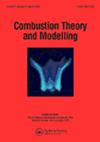A simplified two-mixture-fraction-based flamelet modelling and its validation on a non-premixed staged combustion system
IF 1.6
4区 工程技术
Q4 ENERGY & FUELS
引用次数: 2
Abstract
A simplified two-mixture-fraction-based flamelet model is proposed in this work for a non-premixed staged combustion mode in which three feeds are introduced into the flow field. As the third stream is injected downstream of the main port, the system can be considered a special case of the two-mixture-fraction-based systems. It is considered that if a well-mixing is achieved in the upper stream prior to the third-stream injection, the simplification of the two-mixture-fraction-based flamelet model is feasible. In this work, a simplified model is proposed which can greatly reduce the library size compared to the complete two-mixture-fraction-based flamelet library providing identical resolutions for the fuel stream mixture fraction and the progress variable, respectively. Analysis associated with the interpolation strategy has been implemented. Extension of the current model for the cases in which the well-mixing state is not attained is also analysed, as well as the consideration of heat loss. To validate the model, two adiabatic cases of two-dimensional (2D) direct numerical simulations (DNS) have been performed in this work. To describe the chemical events, one is using finite-rate chemistry (FRC), while the other one is realised by means of the current flamelet model (FLM). An a priori test case that directly looks up the libraries by using the tracking parameters obtained from the FRC case is also considered. It is observed that the interpolation along the primary oxidiser mixture fraction direction outperforms that along directions for both fuel and primary oxidiser mixture fractions. It is also found that three one-mixture-fraction-based flamelet libraries which form the current model are sufficient for simulation of the non-premixed staged combustion, while the extended one which composes five libraries is expected to gain higher accurateness. In the FLM case, although the distributions of tracking parameters deviate from the FRC case slightly, good agreements can be obtained in terms of temperature and species mass fractions. The a priori test shows that the current model can reproduce the reacting flow accurately when the tracking parameters are identical to the FRC case. It is confirmed that the current model can be used to predict the characteristics of the reacting flow in the non-premixed staged combustion.基于两种混合物分数的简化小火焰模型及其在非预混分级燃烧系统中的验证
针对流场中引入三种进料的非预混分级燃烧模式,提出了一种简化的基于两种混合物分数的小火焰模型。由于第三股流被注入主端口的下游,该系统可以被视为两种基于混合物馏分的系统的特殊情况。认为如果在第三次流注入之前在上游实现良好混合,则简化基于两种混合物分数的小火焰模型是可行的。在这项工作中,提出了一个简化模型,与完全的基于两种混合物分数的小火焰库相比,该模型可以大大减小库的大小,分别为燃料流混合物分数和进度变量提供相同的分辨率。已经实施了与插值策略相关的分析。还分析了当前模型在未达到充分混合状态的情况下的扩展,以及热损失的考虑。为了验证该模型,本工作中进行了二维(2D)直接数值模拟(DNS)的两种绝热情况。为了描述化学事件,一种是使用有限速率化学(FRC),而另一种是通过当前的小火焰模型(FLM)实现的。还考虑了通过使用从FRC案例中获得的跟踪参数来直接查找库的先验测试案例。观察到,对于燃料和一次氧化剂混合物馏分,沿着一次氧化器混合物馏分方向的插值优于沿着方向的插值。研究还发现,构成当前模型的三个基于一混合物分数的小火焰库足以模拟非预混阶段燃烧,而由五个库组成的扩展小火焰库有望获得更高的精度。在FLM情况下,尽管跟踪参数的分布与FRC情况略有偏差,但在温度和物种质量分数方面可以获得良好的一致性。先验检验表明,当跟踪参数与FRC情况相同时,当前模型可以准确地再现反应流。结果表明,该模型可用于预测非预混分级燃烧中反应流的特性。
本文章由计算机程序翻译,如有差异,请以英文原文为准。
求助全文
约1分钟内获得全文
求助全文
来源期刊

Combustion Theory and Modelling
工程技术-工程:化工
CiteScore
3.00
自引率
7.70%
发文量
38
审稿时长
6 months
期刊介绍:
Combustion Theory and Modelling is a leading international journal devoted to the application of mathematical modelling, numerical simulation and experimental techniques to the study of combustion. Articles can cover a wide range of topics, such as: premixed laminar flames, laminar diffusion flames, turbulent combustion, fires, chemical kinetics, pollutant formation, microgravity, materials synthesis, chemical vapour deposition, catalysis, droplet and spray combustion, detonation dynamics, thermal explosions, ignition, energetic materials and propellants, burners and engine combustion. A diverse spectrum of mathematical methods may also be used, including large scale numerical simulation, hybrid computational schemes, front tracking, adaptive mesh refinement, optimized parallel computation, asymptotic methods and singular perturbation techniques, bifurcation theory, optimization methods, dynamical systems theory, cellular automata and discrete methods and probabilistic and statistical methods. Experimental studies that employ intrusive or nonintrusive diagnostics and are published in the Journal should be closely related to theoretical issues, by highlighting fundamental theoretical questions or by providing a sound basis for comparison with theory.
 求助内容:
求助内容: 应助结果提醒方式:
应助结果提醒方式:


